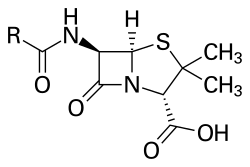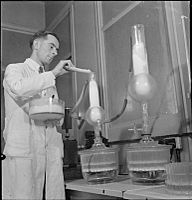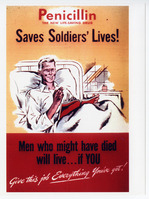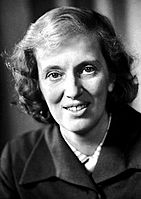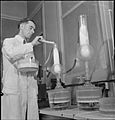Penicillin facts for kids
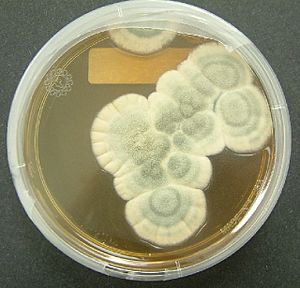
Penicillin is a common antibiotic, used to treat bacterial infections. It was one of the first to be discovered, and worked well against staphylococci and streptococci. Many strains of baceria are now resistant. Chemists keep changing part of its structure in the effort to keep it working against the bacteria.
Penicillin was discovered by Scottish scientist Sir Alexander Fleming in 1928, but it was not mass-produced until the 1940s. The antibiotic is naturally produced by fungi of the genus Penicillium. There is now a whole group of antibiotics derived from Penicillium: penicillin G, procaine penicillin, benzathine penicillin, and penicillin V.
Penicillin is sometimes used to treat tonsillitis, meningitis, and pneumonia as well as other diseases. It was first used widely during World War II.
Penicillin was discovered when Fleming noticed a mould that was stopping bacteria from growing in a petri dish. Australian scientist Howard Walter Florey made the penicillin mould into a medicine. Together with another scientist Ernest Boris Chain, Fleming and Florey were given the Nobel Prize for Medicine in 1945.
Some people are allergic to penicillin. Symptoms include nausea, diarrhea, or rash. Rarely, patients who are allergic to penicillin get a fever, vomit, or have serious skin irritation. Because it is such a popular antibiotic, penicillin is the most common cause of serious allergic reactions to a drug. They are now used regularly in hospitals.
Contents
History
Discovery
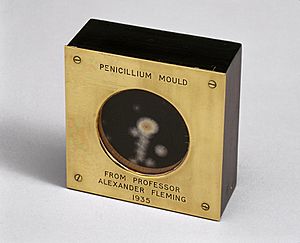
Starting in the late 19th century there had been reports of the antibacterial properties of Penicillium mould, but scientists were unable to understand what process was causing the effect. Scottish physician Alexander Fleming at St. Mary's Hospital in London (now part of Imperial College) was the first to show that Penicillium rubens killed the bacteria. He confirmed this observation with a new experiment on 28 September 1928. He published his experiment in 1929, and called the antibacterial substance (the fungal extract) penicillin.
Fleming thought that penicillin would be a useful antiseptic. He did not convince anyone that his discovery was important. This was largely because penicillin was so difficult to isolate that its development as a drug seemed impossible. It is speculated that had Fleming been more successful at making other scientists interested in his work, penicillin would possibly have been developed years earlier.
The importance of his work has been recognized by the placement of an International Historic Chemical Landmark at the Alexander Fleming Laboratory Museum in London on 19 November 1999.
Development and medical application
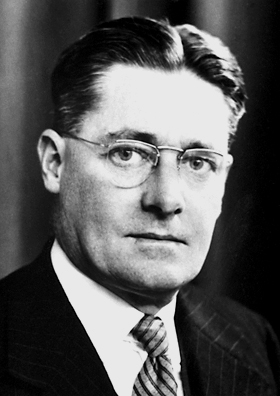
In 1930, Cecil George Paine, a pathologist at the Royal Infirmary in Sheffield, successfully treated ophthalmia neonatorum, an infection in infants, with penicillin (fungal extract) on November 25, 1930.
In 1940, Australian scientist Howard Florey (later Baron Florey) and a team of researchers (Ernst Chain, Edward Abraham, Arthur Duncan Gardner, Norman Heatley, Margaret Jennings, Jean Orr-Ewing and Arthur Gordon Sanders) at the Sir William Dunn School of Pathology, University of Oxford made progress in making concentrated penicillin from fungal culture broth. In 1941, they treated a policeman, Albert Alexander, with a severe face infection; his condition improved, but then supplies of penicillin ran out and he died. Subsequently, several other patients were treated successfully. In December 1942, survivors of the Cocoanut Grove fire in Boston were the first burn patients to be successfully treated with penicillin.
The first successful use of pure penicillin was when Fleming treated Harry Lambert of fatal infection of the nervous system (streptococcal meningitis) in 1942. By that time the Oxford team could produce only a small amount. Florey willingly gave the only available sample to Fleming. Lambert showed improvement from the very next day of the treatment, and was completely cured within a week. Fleming published his clinical trial in The Lancet in 1943. Following the medical breakthrough the British War Cabinet set up the Penicillin Committee on 5 April 1943 that led to projects for mass production.
Mass production
As the medical application was established, the Oxford team found that it was impossible to produce usable amounts in their laboratory. Failing to persuade the British government, Florey and Heatley travelled to the US in June 1941 with their mould samples in order to interest the US government for large-scale production. They approached the USDA Northern Regional Research Laboratory (NRRL, now the National Center for Agricultural Utilization Research) at Peoria, Illinois, where facilities for large-scale fermentations were established. Mass culture of the mould and search for better moulds immediately followed.
On March 14, 1942, the first patient was treated for streptococcal sepsis with US-made penicillin produced by Merck & Co. Half of the total supply produced at the time was used on that one patient, Anne Miller. By June 1942, just enough US penicillin was available to treat ten patients. In July 1943, the War Production Board drew up a plan for the mass distribution of penicillin stocks to Allied troops fighting in Europe. The results of fermentation research on corn steep liquor at the NRRL allowed the United States to produce 2.3 million doses in time for the invasion of Normandy in the spring of 1944. After a worldwide search in 1943, a mouldy cantaloupe in a Peoria, Illinois market was found to contain the best strain of mould for production using the corn steep liquor process. Pfizer scientist Jasper H. Kane suggested using a deep-tank fermentation method for producing large quantities of pharmaceutical-grade penicillin. Large-scale production resulted from the development of a deep-tank fermentation plant by chemical engineer Margaret Hutchinson Rousseau. As a direct result of the war and the War Production Board, by June 1945, over 646 billion units per year were being produced.
G. Raymond Rettew made a significant contribution to the American war effort by his techniques to produce commercial quantities of penicillin, wherein he combined his knowledge of mushroom spawn with the function of the Sharples Cream Separator.
By 1943, Rettew's lab was producing most of the world's penicillin. During World War II, penicillin made a major difference in the number of deaths and amputations caused by infected wounds among Allied forces and saved an estimated 12%–15% of lives. Methods for mass production of penicillin were patented by Andrew Jackson Moyer in 1945. Florey had not patented penicillin, having been advised by Sir Henry Dale that doing so would be unethical.
After World War II, Australia was the first country to make the drug available for civilian use. In the U.S., penicillin was made available to the general public on March 15, 1945.
Fleming, Florey, and Chain shared the 1945 Nobel Prize in Physiology or Medicine for the development of penicillin.
-
Dorothy Hodgkin determined the chemical structure of penicillin.
Images for kids
-
Chemical structure of Penicillin G. The sulfur and nitrogen of the five-membered thiazolidine ring are shown in yellow and blue respectively. The image shows that the thiazolidine ring and fused four-membered β-lactam are not in the same plane.
-
Alexander Fleming, who is credited with discovering penicillin in 1928.
-
Sample of penicillium mould presented by Alexander Fleming to Douglas Macleod, 1935
See also
 In Spanish: Penicilina para niños
In Spanish: Penicilina para niños


